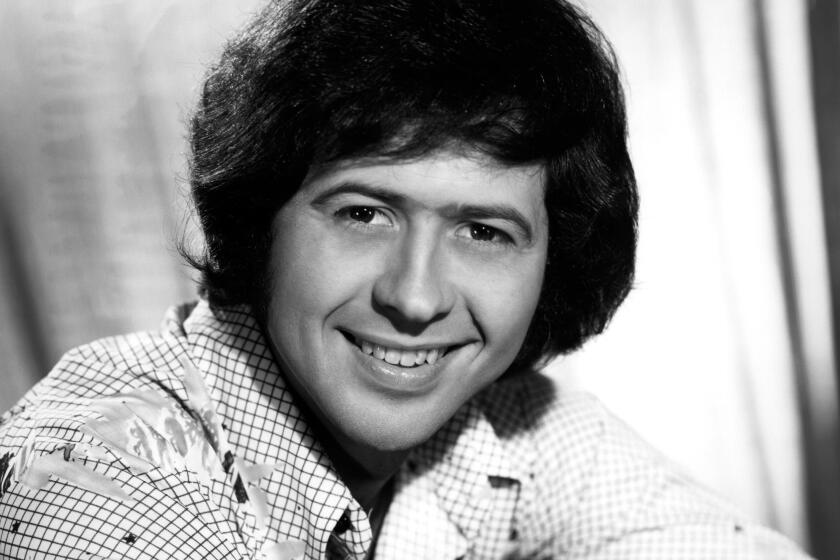Chico O’Farrill; Helped Lead Transformation of Latin Jazz
Chico O’Farrill, a classically trained Cuban musician who pioneered Latin jazz through ambitious works often written for more celebrated colleagues, died in New York on Wednesday of displastic anemia. He was 79.
Raised in Havana and drawn to America in the late 1940s by the lure of bebop, Arturo “Chico” O’Farrill helped develop Latin jazz into a respected art form through his brilliant arrangements and complex compositions, such as the classic “Afro-Cuban Jazz Suite.” He worked with the best jazz musicians of the day, including Benny Goodman, who is said to have given him his nickname.
But after his heyday of the early 1950s, O’Farrill slipped into decades of relative obscurity following the demise of the big bands, which he considered his instrument. Diminutive and self-effacing, O’Farrill enjoyed a revival in his later years, predating the comeback of those other elderly and forgotten Cubans from the Buena Vista Social Club.
He started recording with his own band again in 1995, ending a 25-year studio hiatus and topping his career with two Grammy nominations. For the last three years, he had performed with his Afro-Cuban Jazz Orchestra weekly at New York’s Birdland, discovered by a new generation of fans from all over the world.
“That’s why this story is not so sad,” said Todd Barkan, who produced O’Farrill’s last three albums on the Milestone/Fantasy label. “He was happy to reaffirm his stature in the field.”
O’Farrill had been dubbed the Duke Ellington of Latin jazz, as much for his personal elegance as for his disciplined craftsmanship in composing and conducting. He could come alive on stage, even as he became increasingly frail. But he was never a flashy showman or self-promoter, a trait that may have cost him otherwise deserved recognition.
“My father was not an attention grabber or publicity seeker,” said his son and pianist, Arturo O’Farrill, who inherited his father’s real name and his orchestra. “He didn’t chase after money or fame or women. My father took pleasure in working and performing his music, and all he really wanted [was] to be given that opportunity.”
O’Farrill was born in 1921 to a well-heeled Cuban family of Irish and German descent. He was expected to follow in the footsteps of his father and grandfather, both lawyers. But when he was sent away as a teenager to a military school in Georgia, he discovered his calling.
The school was meant to straighten out the rebellious youth. Instead, he reveled in the liberating allure of big band jazz, and he learned to play the trumpet. He returned to Cuba a full-blown jazz enthusiast.
O’Farrill has said that his parents, influenced by Cuba’s racial divisions, did not approve of his collaborating with black musicians. Yet his father ultimately relented and O’Farrill started studying under composer Felix Guerrero and performing with Orquesta Bellemar and the Lecuona Cuban Boys.
O’Farrill found traditional Cuban music boring and simplistic. When a friend brought back a Dizzy Gillespie album from New York, he went wild over bebop and decided his destiny was in America.
He moved to New York in 1948 and began ghostwriting for arranger Gil Fuller in the legendary Brill Building. That led to his being noticed by Goodman, who hired the struggling artist despite his initial doubts that Latinos could write jazz. The young Cuban proved him wrong by delivering many hit compositions, including “Undercurrent Blues.”
O’Farrill soon caught the attention of legendary jazz producer Norman Granz, leading to a series of impressive early-’50s recordings on the Verve label, many reissued in 1996 as a two-CD set called “Cuban Blues.”
Encouraged by Granz to stretch out creatively, O’Farrill produced the remarkable, multi-part “Afro-Cuban Jazz Suite,” recorded in 1950 by the Machito Orchestra with Charlie Parker as a featured soloist. The work set a standard in the genre, topped only by O’Farrill’s own follow-up two years later. The composer himself declared “the Second Afro-Cuban Jazz Suite” musically superior to the first.
But when the second opus went relatively unnoticed, O’Farrill was deeply disappointed. He went on to write such classics as Stan Kenton’s “Cuban Episode” and Gillespie’s “Manteca Suite.” But when the big band era faded with the advent of rock ‘n’ roll, O’Farrill moved to Mexico and became almost forgotten.
He returned to the United States in 1965 and continued writing and arranging, notably for Count Basie. Eventually, though, O’Farrill turned to writing commercial jingles to make a living, cranking out Spanish-language ads for companies such as American Airlines and Kentucky Fried Chicken. O’Farrill once said he earned more writing a 30-second commercial than an entire chart for Count Basie. He couldn’t even get work writing for English-language commercials, said his son.
O’Farrill wasn’t known to complain during hard times, said Jorge Ulla, a record producer and filmmaker who was working on a documentary about O’Farrill at the time of his death. The musician relied on his sense of humor and a “disciplined ritual of elegance to dismiss his obscurity,” Ulla said. There’s more to enjoy in life than fame, he’d say, like a fine meal and the company of friends.
O’Farrill’s commercial work led to critiques from fellow musicians that he was wasting his prodigious talent, a charge his son rejects.
“Chico was a gentleman, a dignified, lovely person,” said the younger O’Farrill. “He put food on our table. When times were rough, he really took care of business. A lot of people might fault him for doing that, but I think it was a mark of integrity.”
O’Farrill also leaves his wife of four decades, Lupe Valero, a former singer in Mexico, their daughter, Georgina, a television writer and producer living in the San Fernando Valley, and four grandchildren.
A memorial service is scheduled for Friday at St. Peter’s Church in New York, featuring a performance by the Chico O’Farrill Afro-Cuban Jazz Orchestra conducted by Arturo O’Farrill, with guest appearances by Paquito D’Rivera, Wynton Marsalis “ . . . and whoever wants to bring their horn,” his son said.
More to Read
The biggest entertainment stories
Get our big stories about Hollywood, film, television, music, arts, culture and more right in your inbox as soon as they publish.
You may occasionally receive promotional content from the Los Angeles Times.









